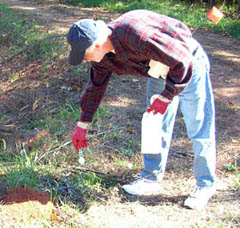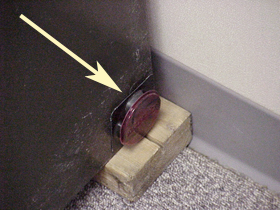Baiting for Ants
go.ncsu.edu/readext?393903
en Español / em Português
El inglés es el idioma de control de esta página. En la medida en que haya algún conflicto entre la traducción al inglés y la traducción, el inglés prevalece.
Al hacer clic en el enlace de traducción se activa un servicio de traducción gratuito para convertir la página al español. Al igual que con cualquier traducción por Internet, la conversión no es sensible al contexto y puede que no traduzca el texto en su significado original. NC State Extension no garantiza la exactitud del texto traducido. Por favor, tenga en cuenta que algunas aplicaciones y/o servicios pueden no funcionar como se espera cuando se traducen.
Português
Inglês é o idioma de controle desta página. Na medida que haja algum conflito entre o texto original em Inglês e a tradução, o Inglês prevalece.
Ao clicar no link de tradução, um serviço gratuito de tradução será ativado para converter a página para o Português. Como em qualquer tradução pela internet, a conversão não é sensivel ao contexto e pode não ocorrer a tradução para o significado orginal. O serviço de Extensão da Carolina do Norte (NC State Extension) não garante a exatidão do texto traduzido. Por favor, observe que algumas funções ou serviços podem não funcionar como esperado após a tradução.
English
English is the controlling language of this page. To the extent there is any conflict between the English text and the translation, English controls.
Clicking on the translation link activates a free translation service to convert the page to Spanish. As with any Internet translation, the conversion is not context-sensitive and may not translate the text to its original meaning. NC State Extension does not guarantee the accuracy of the translated text. Please note that some applications and/or services may not function as expected when translated.
Collapse ▲A bait is a toxic substance mixed with some food item as an attractant (such as sugar). Baits are available in many different formulations, from granules
 that are used mostly outdoors to gels to soft solid materials that are commonly used in kitchens and other areas where ants are active. Consult the NC Agricultural Chemicals Manual for information about commonly used baits Workers find the bait, carry small quantities of it back to the nest, and recruit other workers to the bait. More importantly, workers not only eat the bait as food for themselves, they feed it to the queen(s) and brood. If enough bait is taken and consumed, the entire colony may be killed.Baits have some advantages over other types of insecticides. First, baits can work when the nest cannot be found or it is inaccessible for treating with other chemicals. Second, they pose less of a risk to children and pets by reducing possible contact with any toxic chemical. Third, baits can kill the entire colony whereas most insecticides sprayed on a surface kill onlythe workers that contact it.
that are used mostly outdoors to gels to soft solid materials that are commonly used in kitchens and other areas where ants are active. Consult the NC Agricultural Chemicals Manual for information about commonly used baits Workers find the bait, carry small quantities of it back to the nest, and recruit other workers to the bait. More importantly, workers not only eat the bait as food for themselves, they feed it to the queen(s) and brood. If enough bait is taken and consumed, the entire colony may be killed.Baits have some advantages over other types of insecticides. First, baits can work when the nest cannot be found or it is inaccessible for treating with other chemicals. Second, they pose less of a risk to children and pets by reducing possible contact with any toxic chemical. Third, baits can kill the entire colony whereas most insecticides sprayed on a surface kill onlythe workers that contact it.
Baits are effective only if they are eaten by the ants and not all baits are equally attractive to different ant species. Make sure the bait you use is acceptable to the ants. Place a small amount of bait where you see ants foraging and then watch their reaction for a few minutes. If the ants show no interest in the bait, try a different bait until you find one that they will will readily eat. Once you find a bait that is acceptable to the ants, several other factors determine its effectiveness:
- Proper placement – Bait should be placed in known or suspected areas of ant
 activity. Be sure that bait is placed out of the reach of children, pets, and wildlife. Never place bait directly on countertops where food is prepared or an area where it will get wet and contaminated or where it may accidentally contaminate water in a sink.
activity. Be sure that bait is placed out of the reach of children, pets, and wildlife. Never place bait directly on countertops where food is prepared or an area where it will get wet and contaminated or where it may accidentally contaminate water in a sink. - Quantity – Make sure you provide enough bait and that it remains fresh. If the ants carry away all of the bait then they may leave that area and go elsewhere before enough bait is spread within the colony. Large ant colonies may require more than one application of the bait.
- Sanitation – Baits work best when there are no other food sources accessible by the ants. Keep the area clean so the ants are not “distracted” from locating and feeding on the bait.
- Durability – baits will eventually become unacceptable if they are exposed to high temperatures, rain and sunlight. Check baited areas for signs of ant feeding and replace baits that are no longer acceptable to the ants.
Patience is important to successful baiting. Most ant baits are slow-acting. Therefore, you may continue to see ants for a week or more after baiting. It is important that the ants are able to return to the nest with the bait so it can be fed to other members of their colony. Do not disturb or kill the ants with insect sprays or other means. Spraying the ants (or the area baited) will contaminate the bait and other ants will avoid it. If you are baiting indoors and do not wish to see ants, try placing the bait in less obvious areas (but where you see some ant activity) such as under/behind appliances, sinks, etc.


